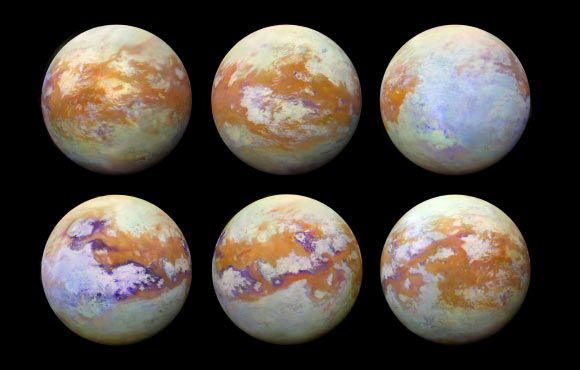The newly-released series of images, made from data obtained by the Visual and Infrared Mapping Spectrometer (VIMS) instrument on board NASA’s Cassini spacecraft, is by far the best representation of how the globe of Saturn’s moon Titan might appear to the casual observer if it weren’t for the moon’s hazy atmosphere.

These images of Titan were created using 13 years of data acquired by Cassini’s VIMS instrument. Image credit: NASA / JPL-Caltech / University of Nantes / University of Arizona.
Observing the surface of Titan in the visible region of the spectrum is difficult, due to the globe-enshrouding haze around the moon.
This is primarily because small particles called aerosols in the moon’s upper atmosphere strongly scatter visible light.
But Titan’s surface can be more readily imaged in a few infrared ‘windows’ — infrared wavelengths where scattering and absorption of light is much weaker.
“This is where the VIMS instrument excelled, parting the haze to obtain clear images of Titan’s surface,” Cassini scientists explained.
“The six new infrared images are the result of a focused effort to smoothly combine data from the multitude of different observations VIMS made under a wide variety of lighting and viewing conditions over the course of Cassini’s mission.”
“They represent some of the clearest, most seamless-looking global views of the moon’s surface produced so far.”

Titan in visible light; this view is among the last images NASA’s Cassini spacecraft sent to Earth before it plunged into Saturn’s atmosphere. Image credit: NASA / JPL-Caltech / Space Science Institute.
Making mosaics of VIMS images of Titan has always been a challenge because the data were obtained over many different flybys with different observing geometries and atmospheric conditions.
One result is that very prominent seams appear in the mosaics that are quite difficult for imaging scientists to remove.
But, through laborious and detailed analyses of the data, along with time consuming hand processing of the mosaics, the seams have been mostly removed.
“It is quite clear from this set of images that Titan has a complex surface, sporting myriad geologic features and compositional units,” the researchers said.







